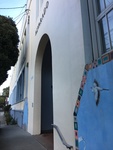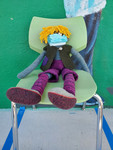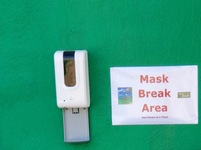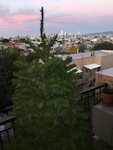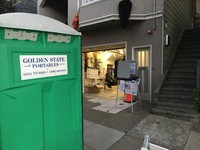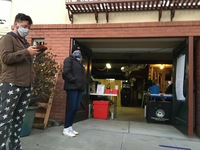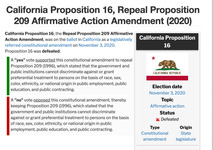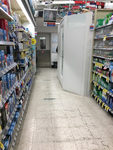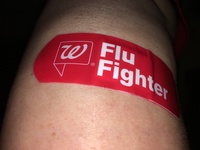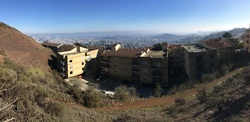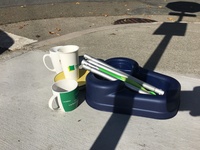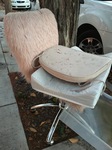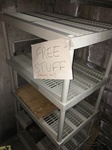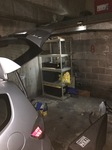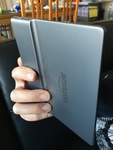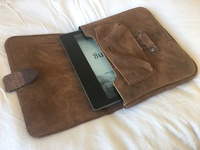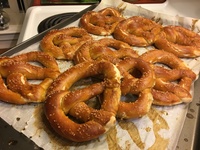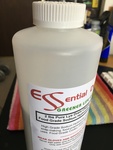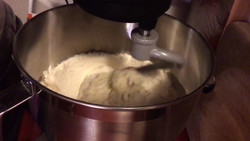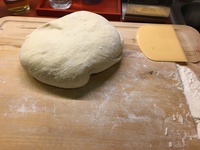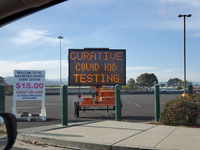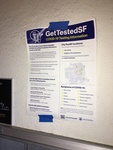 |
| Angelika/Mike Schilli |
Angelika While most students at public schools in San Francisco and the surrounding area have been struggling with distance learning since March, private schools here have reopened their doors. Education policy in the USA takes place at the local level, so it is entirely possible that the state of California allows school openings despite the pandemic, but the individual counties still resist.
Despite low infection numbers in September and October, nothing changed for public schools in San Francisco. The school where I work is not in San Francisco but in neighboring San Mateo. However, in San Mateo, only private schools have returned to in-person instruction so far. Why can private schools now welcome students back on campus, but public schools cannot?
Private schools generally have more money and better facilities since they are funded by tuition fees rather than state funds. They often operate more flexibly because they are usually single schools and not part of larger school districts that local school authorities have to manage. The staff are not unionized, so employment contracts do not need to be negotiated with teachers' unions. Surprisingly, the teachers' union is very influential in the USA, even though unions, except in some key industries, do not play a major role. In the context of school reopenings, the unions naturally want to be involved to represent their members, the teachers. There are many points of contention: What is considered safe? Who provides the protective masks? Which age groups return to school first? What happens to teachers who belong to a high-risk group?
In private schools, things are often handled in a less bureaucratic manner. For example, we received $50 per staff member to buy protective masks. The children bring their own masks. There are emergency supplies of masks paid for by the school. Other protective measures were also funded from the school's budget, which did not have to go through any committees first.
You can see, my school (Rundbrief 12/2018) has been open again since September. We applied for a special permit from the state of California, which our Governor Newsom primarily allowed for elementary schools in the summer. We had to develop a safety plan that covered the pandemic requirements of the local and American health authorities (Center for Disease Control, CDC). Our administration initially submitted this plan to the local health authority in San Mateo, which reviewed it and then forwarded it to the California Department of Public Health. At the end of August, we received approval to reopen.
However, the devastating wildfires intervened. The poor air quality forced the school to its knees again, and we had to postpone the opening once more. But by mid-September, it finally happened. After endless, exhausting months of distance learning, we saw our students not on a screen but sitting in the classroom again. Since we are a very small school with very few students in each class, we were able to meet the requirements well. Each student has their own desk surrounded by plexiglass. My desk, which I hardly sit at when the children are there, and my colleague's desk are also shielded with plexiglass. I always feel like I'm at a bank's cash dispenser.
The students' desks are all at least 2 meters apart. The air is filtered by a specially purchased super filter. Each student has their own materials as much as possible. Otherwise, we disinfect. All students (and, of course, staff), no matter how old, wear masks always and everywhere: in the classroom, on the playground, in the restroom. The children are usually only allowed to take off their masks for eating or drinking, and only outside at designated tables where social distancing can be maintained. The spots are marked with green and red circles so that the students know where they can sit to eat.
Outside, in front of each classroom, there is also a designated area where students can take a mask break. They are allowed to sit on a chair and remove their mask there. The start and end times of the school day are staggered for each class, as are the breaks, so our students do not come into contact with students from other classes. Every morning, fever is measured, and a questionnaire with COVID-19 symptoms is checked before the children enter the school grounds. We all have rough hands from so much hand washing. Whenever the children enter or leave the classroom, such as before and after recess, they have to wash their hands. Fortunately, we have a large sink right at the entrance. If a child shows any COVID-19 symptoms, such as a runny nose, they are not allowed to come to school until a negative COVID test is presented. All staff members must take a COVID test at least every four weeks if there are no symptoms. If symptoms are present, they must stay home and get tested immediately.
The whole situation certainly sounds terribly regulated. I admit that I had major concerns about whether my students could handle all the rules, as I work with children who are not that easy to manage. But the children proved me wrong. No one complains about wearing masks or constant hand washing. The children were all so happy to be allowed back to school that they accepted all the regulations. Nothing is worse for them than sitting isolated in front of the computer, even for a generation that loves video games.
Somehow, it also comforts me that personal contact is so highly valued by them. In my opinion, the effects of isolating children during COVID are being completely downplayed. So far, despite the enormously rising numbers across the country, we have managed quite well through the crisis at our school. After the winter break, we will do at least one week of distance learning again because we can't really control what the individual students and staff do during the holidays. Do they adhere to the regulations or contact restrictions? During the first week of distance learning, everyone must get tested, and no one is allowed back to school without a negative test. Despite the renewed lockdown in San Francisco and the surrounding area, schools that are already open are allowed to remain open.
Michael If Americans buy a Christmas tree at all, they usually start looking for it at Thanksgiving at the end of November. They also set it up and decorate it right away, because after all, this way they get more out of their investment.
Angelika also wants a Christmas tree every year, but she prefers to buy it shortly before the 24th and set it up only on the 24th. A week before the holiday, the sales locations usually still offer acceptable trees, but at our usual spot this year, there were only three-meter-tall giant trees and one-meter-small mini trees left; the mid-sized trees were completely sold out. We eventually found one that was 2 meters 10, but when we asked how much it would cost, the man said dryly: 176 dollars, which made us reconsider.
After an hour of driving across the city, checking various Safeway parking lots where trees were supposedly being sold according to the internet, but in reality only housed already closed sales shacks, we finally found success at a garden center by the ocean. From the five remaining trees, we chose the best one, and while the employee was tying the tree to our car roof, he told us that this year had been particularly crazy. Many more people than usual were staying in the city for the holidays, and while the store typically sold 600 Christmas trees per season, they had wisely ordered 1,000 this year, but they were now practically all gone, and getting more stock quickly was not possible.
So now a $119 tree stands on our balcony, waiting for December 24th, when it will be allowed into the living room and be decorated by Angelika herself in an elaborate process. Meanwhile, I write articles for computer magazines or go surfing.
Michael Now that the presidential election is over, readers of the newsletter might be wondering how people in America vote. While in Germany, a polling station often opens in the nearest elementary school, things can be a bit more rustic here in San Francisco. In our neighborhood, some residents run official polling stations in their home garages. This is no joke; as you can see from the photos, these volunteers receive official ballot boxes and papers and are responsible for properly delivering the cast votes to the official authorities.
Due to the election process called the 'Electoral College' in America, each state individually determines the president. Some states have historical preferences, and since a candidate is chosen in each state on a winner-takes-all basis, a supporter of the Republican Party in California might as well not bother voting, because California has voted for the Democratic candidate for the past 40 years. Rumor has it that even a cardboard cutout of a Democrat would still have a better chance in California than the most moderate conservative politician.
But as always, the presidential election was bundled with the abundantly practiced California ballot initiatives, the so-called 'Ballot Measures.' Citizens here can vote directly on various issues, such as 'Proposition 18,' which proposed lowering the voting age to 17 (rejected by 56%). Or 'Proposition 16,' which would have allowed the state, contrary to the Constitution, to give preferential treatment to ethnic minorities (rejected by 57.2%). Or 'Proposition 22,' which allows taxi companies Uber and Lyft to classify drivers as independent contractors rather than employees (approved by 58.6%).
So, when a Californian goes into a garage polling station, they receive a huge ballot and have to check not only 'Trump' or 'Biden,' but also several dozen boxes for numbered propositions. The ballot measures are named at the discretion of the petitioners, and it is often not easy to figure out what voting 'Yes' or 'No' actually means. For example, the vote on Proposition 16 was formulated as follows: 'Repeal Prop 209 Affirmative Action Amendment.' It was about repealing an old proposition from 1996, which prohibited the state from treating citizens unequally just to benefit certain minorities.
Back then, it was a halt to the so-called 'Affirmative Action,' a state program that tried to improve the living conditions of minorities like Blacks or Latinos through state interventions, for example, by giving them preferential consideration in college admissions. This, of course, angered other groups like Whites or Asians, who, despite better grades, were at a disadvantage. So, in 1996, Prop 209 determined that this was not lawful. Prop 16 in 2020 brought this old issue back and aimed to legalize this unequal treatment again. Therefore, voting 'Yes' on the ballot was in favor of repealing the old proposition, thus legalizing unequal treatment.
By voting 'No,' one voted against the repeal, thereby supporting the continuation of the current practice of equal treatment. To ensure that even people without a higher education are not overwhelmed, websites like ballotpedia.org explain what a 'Yes' and 'No' vote means for each question. Voters often enter polling stations with self-written tables that indicate which box to check for each number to achieve the political outcomes they planned at home. Some also bring cheat sheets from activists, listing the recommended choices for those they trust to copy. The result: As mentioned above, Prop 16 was rejected by 57.2% of California voters, so it remains illegal for the state to grant advantages to minorities. The principle of equal treatment remains in place.
Angelika I haven't had the flu often in my life, but there was one time when it really got me. We were still living in Munich, and I thought I was indispensable at work, so I went in with a fever, which immediately backfired, sending me into a fever delirium and incapacitating me for quite a while. For some time now, I've been telling myself every year that this year, I'll get the flu shot, but then I didn't do it, even though it's recommended due to my work with children.
But due to Corona and the fact that I have to stay home and get tested for any symptom that is on the official Covid list, I thought to myself, 2020 is my year for the flu shot. This is because flu and Corona symptoms are hard to distinguish from each other. Of course, I didn't want to sit in my doctor's waiting room with all the coughing and sneezing people just for a vaccination. But you have to give it to the Americans; sometimes they are very pragmatic. here, anyone can get vaccinated in the drugstore.
As has often been reported here, in the USA there isn't a classic pharmacy as you know it from Germany. Pharmacies are either located in drugstores like "Walgreens" and "CVS" or in supermarkets like the "Safeway" chain. German visitors always find it a bit strange that non-prescription medications like aspirin are available on the regular shelves in the supermarket. However, for prescription medications, you still need a prescription in the U.S., but you can get the medication from behind the counter in the back of a drugstore.
In the U.S., the profession of a pharmacist also exists, and every drugstore or supermarket that offers prescription medications employs one. In all American states, these pharmacists are allowed to administer vaccinations to adults (not all states permit this for children). Generally, anyone wanting a vaccination can simply show up at the store to get vaccinated, or can make an appointment online.
If you have health insurance, it covers the vaccination, and the drugstore bills the insurance company directly. I just had to present my insurance card. My insurance fully covered the flu vaccination. I made an appointment online at the Walgreens around the corner from us and got one for the same day. Then I just needed to provide my birthdate, address, and name, and answer a few questions such as whether I was feeling sick or if I had ever had an allergic reaction to vaccinations.
At the appointed time, I went to the Walgreens drugstore, checked in at the pharmacy area, and after a few minutes, the on-duty pharmacist came. She led me into a box-like structure that looked like a small container, which turned out to be a tiny room with a chair. She confirmed my details once again and then administered the vaccination in my arm. I had always wondered what that huge, person-sized box at the end of the aisle in Walgreens was for when I was shopping there. Now I know! By the way, you can not only get flu vaccinations in drugstores but also vaccinations for all sorts of other things (shingles, whooping cough, hepatitis). I read in the German media that this year in Germany, there are the first pilot projects testing flu vaccinations in selected pharmacies.
Michael As previously mentioned (Rundbrief 05/2020) we go for a walk around our neighborhood almost every evening to keep ourselves somewhat fit, even during pandemic times. By now, we have walked so many miles that Angelika's hiking boots have worn out, but we simply ordered the same model again from the outdoor outfitter REI, this time online instead of in the store. The next 10,000 miles can come.
It's not about the destination of the walk for us, but the journey. Sometimes we have a chat with the postman who is still delivering the last letters in the evening, or we laugh about a family on 23rd Street who sit on the steps of their house every evening and have happy hour with wine with their neighbors, who are sitting a few steps lower due to social distancing.
We also marvel at what people in the neighborhood put out on the street with a "Free" sign, hoping someone will take it. Whether it's a collection of 100 LPs, a pair of no-longer-needed crutches, an old grill, or a worn-out office chair, each item tells its own story. Sometimes there's even an antique cabinet available, but I always have to stop Angelika because, unfortunately, we don't have space at home.
Once, someone had placed a very sturdy, two-meter-high plastic shelving unit outside, and we immediately knew we could use it for our underground parking space to organize old junk that was scattered on the floor. So, we turned around, hurried home, and got the car. Fortunately, the shelf was still there. I disassembled it, we loaded it up, drove it home, and then continued our interrupted walk. Later, we set it up, and now the garage looks so neat and tidy!
This practice of putting old junk on the street for others to take is not entirely without controversy in the neighborhood. Sometimes, neighbors get upset on the internet portal Nextdoor when stuff that should really be thrown in the trash or picked up by bulk waste collection sits on the street for days. When I put something out, usually old but still functional computer parts, cables, or tools I no longer need, I check again at dusk to see if anyone has taken it. If not, I bring it in overnight and put it out again the next day. If no one takes it by then, it goes in the trash. After all, I am a model neighbor!
Michael We have been reading books almost exclusively on electronic devices for some time now. For large-format coffee table books, I use my large iPad Pro, while for text books, various Kindle devices are used. Amazon offers the latter in several price ranges: the basic version is already quite good, the "Paperwhite" version is slightly better for about 50% more, and for the absurd price of $250, there's the millionaire edition, the "Kindle Oasis." Since it's not easy to spend one's hard-earned money during Corona times, I jumped at the chance when Amazon temporarily lowered the price to $175 on Black Friday.
Now I have already read 25% of the lengthy new Obama book on the device, and I must say that I not only appreciate the adjustable warmer front light, but also the peculiar side bezel, which allows the device to be held effortlessly with one hand, even by someone who is dead tired in bed and wants to read three more paragraphs before dozing off.
Where to put the device after reading so it doesn't collect dust? I always disliked classic Kindle covers because they can nearly double the device's weight, making it tiring to hold up. That's why my other Kindles are in simple sleeves, and I hold them without any cover while reading. For the Oasis, I looked for a more exclusive option and found the leather sleeve from the brand "Drink & Hide" on Amazon for $37. This thing is amazing! Extremely soft and pleasantly fragrant leather, highly tactile, and perfectly stitched. It supposedly comes from Guatemala and is only sold online in the USA. Top product!
Michael Fresh pretzels are unfortunately hard to come by in San Francisco. You can buy day-old pretzels from "Esther's Bakery" in Mountain View at the organic supermarket "Rainbow Grocery," but who likes stale pretzels? As previously reported (Rundbrief 06/2016), I discovered a pre-made pretzel baking mix a few years ago. I used it to bake a tray of pretzels every few weeks and was quite satisfied with it.
Due to Corona, I spent a lot of time at home and stumbled across a Youtube-Video with a recipe for perfect pretzels using ingredients like flour, yeast, water, and drain cleaner. You read that right, because it's lye that gives pretzels their typical dark brown color and the distinctive taste that sets them apart from ordinary rolls.
You can order concentrated lye powder online, but be warned, it's potent stuff. Not only does it clear clogged drains, but it also reacts vigorously when it comes into contact with water. That's why you should only briefly dip the pre-formed pretzel dough into a 5% lye solution before placing them on the baking sheet.
Supermarkets in America don't sell yeast as fresh yeast in small paper packets like in Germany, but as powdered dry yeast. That is, they do in normal times. Currently, there seems to be a home baking boom, and yeast is sold out everywhere. Occasionally, you might find a small tin of Italian dry yeast ("Secca") gathering dust in an organic store. However, the American yeast giant "Fleischmann" offers a pound of the stuff on Amazon for about 10 dollars, and that will last a year if you make pretzels every week.
Here's the recipe from the linked video: Dissolve 13g of dry yeast in 365g of lukewarm water and let it sit for 10 minutes. Then, mix 632g of bread flour with 12g of salt and add it to a stand mixer with a dough hook. Slowly pour in the yeast water. After kneading for 5-10 minutes, the dough is ready. Cover the dough and let it rest for 30 minutes, then divide it into approximately 100g pieces. Shape these pieces into 20cm long cylinders and let them rest for another 20 minutes.
Next, roll out the cylinders long and thin, shape them into pretzels, briefly dip them into the diluted lye solution (using disposable gloves), and place them on a baking sheet. Sprinkle coarse salt on the pretzels and bake them in a preheated oven at 420 degrees Fahrenheit (215 degrees Celsius). After 20 minutes, take them out and let them cool on a rack. Done! I made my Own Pretzel Baking Video for YouTube . Check it out, like it, and subscribe, as the pros say.
Angelika As I mentioned at the beginning, one of the requirements at our school is that staff must regularly undergo COVID testing, even if they have no symptoms. However, in early September, it was not easy to get a test without symptoms. San Francisco had test centers that offered tests for people who needed them for work, but only if their workplace was in San Francisco. This made me grind my teeth a bit because, even though my workplace isn't in San Francisco, I am still a resident of this city and pay my taxes here. But anyway.
At other test sites, you could only get a test after a prior video conference, which was also somewhat cumbersome. Then, our administration informed us about the so-called "Project Baseline." They have test centers all over the Bay Area, work with local and state authorities, and the test is available to people without symptoms and is free. However, behind Project Baseline is the company Verily, which is a subsidiary of Alphabet, the parent company of Google.
How does the whole process work? I went to the Project-Baseline-Covid-Website, clicked on the "Get Started" button, and had to sign in with my email. Then, I had to electronically sign several forms confirming that I am 18 years old and agreeing, for example, that it is okay for the COVID sample to be sent to a lab and for the data to be shared with the lab for this purpose. Next, I filled out an online questionnaire about COVID, including questions about my age, symptoms, pre-existing conditions, increased risk due to my job, and so on. Finally, I could schedule an appointment.
I was offered available appointments at test sites in the nearby area. I chose an appointment at a test center in San Mateo, which is conveniently located almost directly across from our school on a fairground. I also had to provide my insurance numbers when scheduling the appointment, as in California, insurance is billed for the test. If you don't have insurance, the test is free. I've taken the test a few times now, and sometimes all the appointments are booked. However, new slots are usually made available each day. I then received a confirmation email with an identification number that everyone needs to bring to their appointment.
Then I drove to the test center in San Mateo. First, I joined the line of cars. Everyone was wearing masks, and the car windows remained firmly closed. An attendant held up a sign asking if I had an appointment with Project Baseline (no appointment, no test). I responded with a thumbs up to indicate yes. The attendant directed me to my lane, as there were also testing options from other providers on the site. Progressing at a snail's pace, I eventually reached another attendant who checked my identification number from the email through the closed window and my driver's license to ensure I was the correct person.
After verifying my identity, an attendant placed a plastic bag with the test tubes under my windshield wiper. The actual test took place in an exhibition hall, which I drove into. There, the tester approached and asked for my name and date of birth again, through the still-closed window. Then, I had to open my car window slightly. The tester handed me a long cotton swab. I closed my window, pulled my mask down from my nose, so my mouth was still covered, and then inserted the cotton swab deep into one nostril, rotating it ten times, and repeated the process in the other nostril. After that, I pulled my mask back over my nose, opened the window a small crack again, and placed the long cotton swab into the test tube that was held out to me. Then, I drove away. After 1-2 days, I received the results via email.
Once you're in the Project Baseline system, for subsequent tests you only need to provide your insurance number to get an appointment, and you can skip the questionnaire. Nowadays, it's generally a bit easier to get a test even if you don't have symptoms, including for children, although Project Baseline starts at 13 years old, while the competitor Curative offers tests from 5 years old. I would have liked to take some photos during the testing process, but that was strictly prohibited.
Angelika On Saturday, November 7th, we were still lounging in bed reading when suddenly cheering and pot banging erupted, growing louder and louder. Biden had won the presidential election after agonizing days of waiting and counting, thanks to winning the state of Pennsylvania. The jubilation expressed the relief many felt in the Democratic stronghold of San Francisco. Honestly, we had never experienced anything like this after an election.
It would be naive to believe that Biden will fix everything. The country is deeply divided, with millions having voted for Trump and convinced that the Democrats stole the election. Even within the Democratic Party, there are political infighting between more moderate and progressive forces. But on that particular Saturday, after an incredibly exhausting year, there was finally a glimmer of hope that all is not lost. As far as I'm concerned, the next four years can be completely boring if it means finally having peace with Biden and Harris. It's already nice not to wake up every morning worried about what outrageous thing Trump has tweeted. Yes, he still disputes his election loss, and we wonder how so many Republican politicians in Washington can still be loyal to him. Nonetheless, many of his party members are preparing for a new era.
How much Biden can accomplish also depends on whether the Republicans will retain the majority in the Senate. This will be decided on January 5th in Georgia, where there are runoff elections for the two Senate seats. If the Senate remains in Republican hands, it will be difficult for Biden, as Mitch McConnell will remain the Senate Majority Leader and will likely obstruct many of Biden's initiatives. In my opinion, McConnell is one of the most powerful politicians in the country. I will write more about him in an upcoming newsletter.
Greetings from the city in corona slumber:
Angelika und Michael



